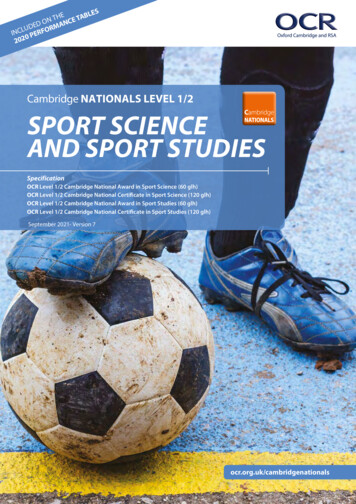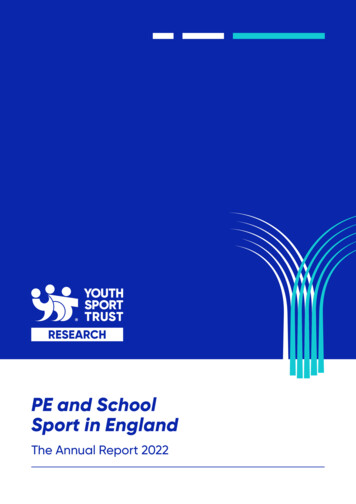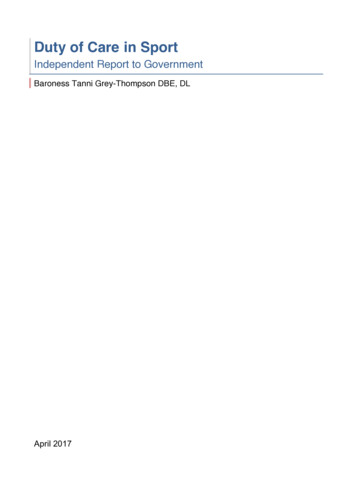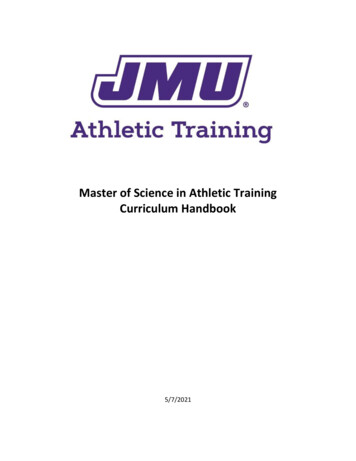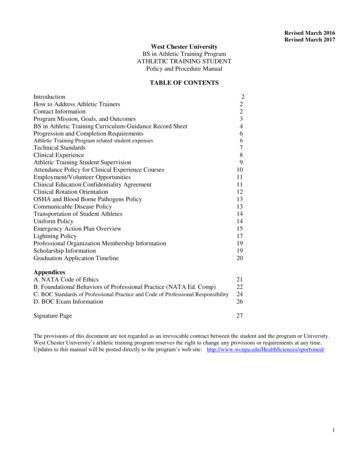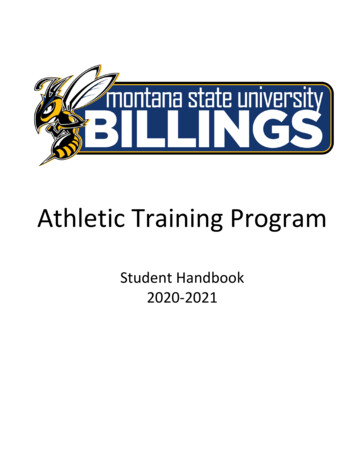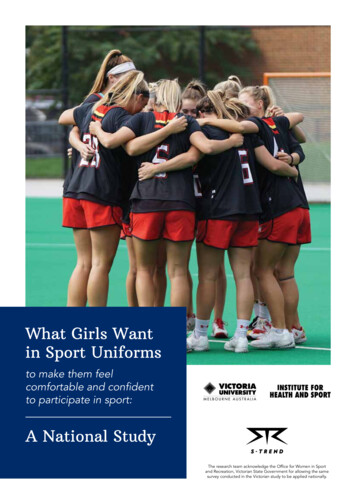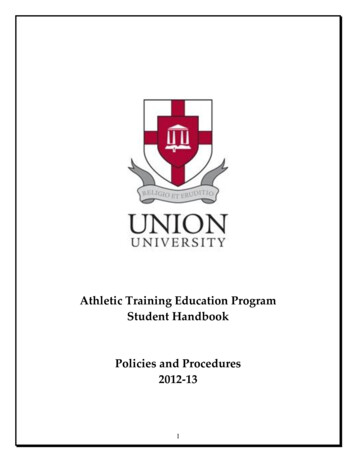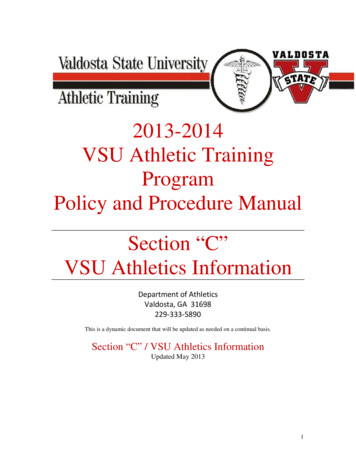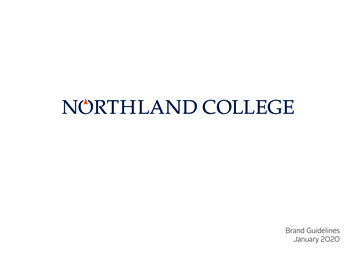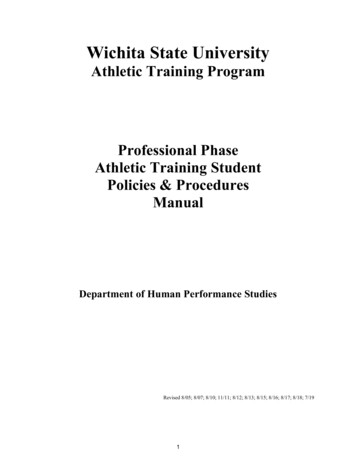
Transcription
Ohji et al. BMC Sports Science, Medicine and 0264-6(2021) 13:37RESEARCH ARTICLEOpen AccessAthletic identity and sport commitment inathletes after anterior cruciate ligamentreconstruction who have returned to sportsat their pre-injury level of competitionShunsuke Ohji1* , Junya Aizawa2, Kenji Hirohata1, Sho Mitomo1, Takehiro Ohmi1, Tetsuya Jinno3,Hideyuki Koga4 and Kazuyoshi Yagishita1AbstractBackground: This study aimed to determine the relationships between athletic identity and sport commitmentand return to sports (RTS) status in athletes after anterior cruciate ligament reconstruction (ACLR).Methods: Thirty-nine participants post-ACLR (8–24 months) were included in this cross-sectional study. Measuresincluded the athletic identity measurement scale and sport commitment scale. In addition, we measuredkinesiophobia and psychological readiness using the Tampa Scale for Kinesiophobia and ACL-Return to sport afterinjury scale. The subjects were categorized into Yes-RTS or No-RTS based on two questions to determine whetherthey were returning to sport at the same level of competition as before the injury. A Chi-squared test, Fisher’s exacttest, unpaired t-test, and Mann-Whitney’s U test were used to analyze the data.Results: The Yes-RTS group had significantly higher scores on the athletic identity measurement scale (P 0.023,effect size [ES] 0.36), sport commitment scale (P 0.027, ES 0.35), and ACL-Return to sport after injury scale(P 0.002, ES 0.50) and significantly lower Tampa Scale for Kinesiophobia scores (P 0.014, ES 0.39)compared to the No-RTS group.Conclusion: Athletes who returned to sports at the same level of competition as before the injury had higherathletic identity and sport commitment and lower kinesiophobia compared to those who did not return to sportsat the same level of competition. These self-beliefs regarding sport may play an important role in post-ACLRathletes’ RTS.Keywords: Athletic identity, Anterior cruciate ligament reconstruction, Sport commitment, Return to sport, return toperformance* Correspondence: ohji.spt@tmd.ac.jp1Clinical Center for Sports Medicine and Sports Dentistry, Tokyo Medical andDental University, 1-5-45 Yushima, Bunkyo-ku, Tokyo 113-8519, JapanFull list of author information is available at the end of the article The Author(s). 2021 Open Access This article is licensed under a Creative Commons Attribution 4.0 International License,which permits use, sharing, adaptation, distribution and reproduction in any medium or format, as long as you giveappropriate credit to the original author(s) and the source, provide a link to the Creative Commons licence, and indicate ifchanges were made. The images or other third party material in this article are included in the article's Creative Commonslicence, unless indicated otherwise in a credit line to the material. If material is not included in the article's Creative Commonslicence and your intended use is not permitted by statutory regulation or exceeds the permitted use, you will need to obtainpermission directly from the copyright holder. To view a copy of this licence, visit http://creativecommons.org/licenses/by/4.0/.The Creative Commons Public Domain Dedication waiver ) applies to thedata made available in this article, unless otherwise stated in a credit line to the data.
Ohji et al. BMC Sports Science, Medicine and Rehabilitation(2021) 13:37BackgroundMost athletes with an anterior cruciate ligament (ACL) injury undergo ACL reconstruction (ACLR) with the goal toreturn to sport (RTS) at the same level of competition asbefore the injury [1] but only 63% of athletes are able toachieve this [2]. Multiple factors are associated with RTSafter ACLR, including injury site and surgical technique,physical functioning, and psychology [3]. The influence ofpsychological factors is particularly large in athletes in theRTS phase [2, 4]. Compared to before the injury, athletesRTS after ACLR have the following psychological characteristics: weak kinesiophobia (fear of re-injury and movement) [5–7], high self-efficacy [6], high self-esteem [8],and high psychological readiness to RTS [6, 9, 10].Recently, athletic identity and sport commitment havebeen recognized as important psychological variablesthat could be related to RTS status post-ACLR [4, 8, 11,12]. Athletic identity is the sport-specific component ofan individual’s self-concept and is the extent to which anindividual identifies with the athletic role [13]. PostACLR athletes with a higher degree of athletic identityshow greater adherence to rehabilitation [14]. Sportcommitment is defined as a psychological state representing the desire and resolve to continue participatingin a particular athletic program, specific sport, or sportsin general [15]. Athletes who have suffered severe injuries, including ACL injuries, can continue being committed to RTS through sport commitment [11].Based on these studies, it is expected that athleticidentity and sport commitment would be associated withRTS status in post-ACLR athletes. However, no previousstudy has quantified the relationship between athleticidentity and sport commitment and RTS status followingACLR. Therefore, the purpose of this study was to determine the relationships between athletic identity andsport commitment, and RTS status in athletes afterACLR. We hypothesized that post-ACLR athletes whohave returned to sports at their pre-injury competitionlevel have higher athletic identity and sport commitmentscores compared to athletes who have not returned tosports.Page 2 of 7affects RTS; had not participated in sports for social reasonssuch as pregnancy or employment; had a cartilage injury requiring surgery; and had difficulty in follow-up until RTS.The sample size was analyzed using G*Power software [19].The minimum sample size was calculated to be 38 patientsin total, referring to the effect size determined from previous studies [6, 9, 10, 20, 21] analyzing group differences inACL-Return to sport after injury scale (ACL-RSI) andTampa Scale for Kinesiophobia (TSK) scores (effect size 0.96, alpha 0.05, power 0.80, two-tailed). All surgerieswere performed by orthopedic surgeons specialized in kneejoint. The autograft sources were hamstrings or bonepatellar tendon-bone. The surgery technique and postoperative rehabilitation protocol were based on previous research [22]. Jogging started 3 months post-ACLR, and therunning speed was gradually increased. Sports participationwas allowed by a doctor when the following were achieved:it was at least 6 months after surgery; the limb symmetryindex (LSI) on the single-leg hop for distance was 90%;and the LSI of isokinetic knee flexion and extensionstrength was 85%, as measured with an IsokineticDynamometer (BIODEX System 4, BIODEX Medical Inc.,Shirley, NY) at 60 /s and 180 /s).ProceduresThis was a cross-sectional study completed in a singlecenter. Demographic, injury, and surgical informationwere collected from medical records. Sport type, participation level, and psychological variables were collectedusing a questionnaire. Sport type was categorized as collision, contact, limited contact, and noncontact based ona previous study [23]. Participation level was categorizedas recreation, competitive, and elite based on a previousstudy [8]. Ethical approval was obtained from the EthicsCommittee (approval number: M2016–197). All subjectsprovided written informed consent before participation.The Strengthening the Reporting of Observational Studies in Epidemiology (STROBE) Statement was used asguidance when reporting the design of this study [24].Psychological variablesMethodsParticipantsParticipants who had undergone primary ACLR betweenAugust 2015 and May 2019 were included if they met thefollowing inclusion criteria: (1) they were 16 to 45 years oldat the time of measurement [10, 16]; (2) their sport participation estimated with a modified Tegner activity scale [17]was 5 before ACL injury; (3) it had been 8–24 monthssince the surgery [18]; and (4) they had indicated anintention to RTS before surgery. Participants were excludedif they had an ACL injury to the contralateral knee or ACLreinjury to the reconstructed knee; had a complication thatThis study measured athletic identity and sport commitment as psychological variables. In addition, wemeasured kinesiophobia and psychological readinessusing standard psychological measures that havealready been found to be associated with RTS statusafter ACLR [5, 6, 10].Athletic identity was assessed with the Athletic IdentityMeasurement Scale (AIMS) [13]. The AIMS is a 10-itemquestionnaire where responses are on a seven-point Likertscale that ranges from 1 (strongly disagree) to 7 (stronglyagree). Total scores range from 7 to 49, with higher scoresindicating stronger athletic identity. The Japanese version of
Ohji et al. BMC Sports Science, Medicine and Rehabilitation(2021) 13:37the AIMS was used, which has good internal consistencyand good criterion-related and construct validity [25].Sport commitment was measured using the SportCommitment Scale (SCS) [15]. The Japanese version ofthe SCS [26] was used. This scale is a self-report inventory measuring an athlete’s psychological desire to continue sport participation. SCS is a six-item questionnairewhere responses are provided on a five-point Likertscale. Total scores range from 6 to 30, with higher scoresindicating greater sport commitment. The SCS has goodreliability (internal consistency, reproducibility) and validity (construct and criterion-related validity) [26].Kinesiophobia was measured using the TSK [27]. TheJapanese version of the TSK was used [28]. The TSK is a17-item questionnaire with a four-point Likert scale.Total scores range from 17 to 68, with higher scores indicating greater kinesiophobia. The TSK has good internal consistency [27].The ACL-RSI is designed to measure comprehensive psychological readiness to RTS after ACL injury or reconstruction surgery [29]. It is a 12-item questionnaire and includesthree domains: emotions, confidence in performance, andrisk appraisal. Scores for each domain are summed and averaged for a total score between 0 and 100. Higher scores indicate greater psychological readiness to RTS. The Japaneseversion of the ACL-RSI was used; it has good internalconsistency, construct validity, and reliability [30].RTS statusTo determine RTS status, all subjects responded to twoquestions, one of which was a continuous variable andthe other was dichotomous. The continuous variablequestion was assessed using post-operative subjectivePage 3 of 7athletic performance (POSAP) on a scale of 0–100%[22]. In the dichotomous question, the participants wereasked to answer “Yes” or “No” if they were returning tothe same level of sports as before the injury [5, 21, 31–33]. The subjects who answered 80% for the PoSAPand “Yes” to the dichotomous question were included inthe Yes-RTS (YRTS) group. The No-RTS (NRTS) groupincluded those who met none or only one of the criteria.Statistical analysisThe normality of the distribution of each variable wasdetermined by a histogram and the Shapiro–Wilk normality test. The differences between the NRTS andYRTS groups in demographic data and psychologicalvariables were analyzed using the chi-squared test, Fisher’s exact test, unpaired t-test, and Mann-Whitney’s Utest. The effect sizes (chi-squared test or Fisher’s exacttest φ coefficient, Cramer’s V, t-test Cohen’s d,Mann-Whitney’s U test r) were also calculated for eachvariable. Psychological variables may be influenced byactivity levels and the months since the surgery. Thus,Spearman’s rank correlation coefficient (ρ) was calculated between the modified Tegner activity scale and themonths since the surgery, and the psychological variables. The a priori α level was 0.05. Data were analyzedusing SPSS Ver. 21.0 (IBM Corp, Armonk, NY).ResultsForty-one participants met the criteria for this study, buttwo refused to participate (Fig. 1). Therefore, 39 participants were included in the analysis. The demographicinformation of these athletes is presented in Table 1. Intotal, 16 athletes (41%) were assigned to the NRTSFig. 1 Participant flow chart. ACLR, anterior cruciate ligament reconstruction
Ohji et al. BMC Sports Science, Medicine and Rehabilitation(2021) 13:37Page 4 of 7Table 1 Demographic variable distributionsNRTS (n 16)YRTS (N 23)P valueEffect sizeAge, ya23.0 (20.3)20.0 (4.0)0.044 0.32Sex (female/male), n5/1112/110.1670.21Body mass index25.9 (9.0)22.3 (2.8)0.116 0.25Injury type (contact/non-contact), n4/125/180.5540.04Months from surgery11.5 (5.5)12.0 (5.0)0.635 0.08Days from injury to surgerya68.5 (41.0)81.0 (100.0)0.607 0.08Graft type (hamstring/BTB), n14/220/30.6740.01Meniscus repair (yes/no), n12/416/70.5000.06Pre-injury modified Tegner scale8.0 (2.5)8.0 (1.0)0.551 0.10Sports type (Collision/Contact/Limited contact/Noncontact), n4/6/1/59/8/1/50.8050.16Participation level (Recreation/Competitive/Elite), n4/11/11/17/50.0980.35aaaaMedian (inter interquartile range)NRTS no-return to sports, YRTS yes-return to sports, BTB bone-patellar tendon-bonegroup, and 23 athletes (59%) were assigned to the YRTSgroup. Four subjects responded “Yes” to the dichotomous question but had a PoSAP 80%. The lowest PoSAPfor the YRTS group was 85%.There were no significant differences in demographicinformation, surgical information, or modified Tegner activity scale scores, sports type, and participation level otherthan age (P 0.044). The data for the psychological variables are shown in Table 2. The YRTS group had a higherAIMS score (P 0.023), SCS score (P 0.027), and ACLRSI score (P 0.002) than the NRTS group. The YRTSgroup had a lower TSK score (P 0.014) than the NRTSgroup.The correlations between the modified Tegner activityscale and months since the surgery and the psychological variables are shown in Tables 3 and 4. No significant correlations were found for each variable.DiscussionThe results of this study showed that the YRTS grouphad significantly higher AIMS, SCS, and ACL-RSI scoresand significantly lower TSK scores compared to theNRTS group. Consequently, the results of the presentstudy supported our hypothesis.A meta-analysis examining the RTS rates of postACLR athletes reported that approximately 63% ofathletes were able to RTS at the same level of competition as before the injury [2]. The YRTS group in thisstudy included approximately 59% of the participants sothe RTS rate for the study population did not differ fromprevious meta-analyses.The dichotomous question evaluating RTS as Yes/Noalone may overestimate the RTS [22]. Therefore, in thepresent study, a matrix of the dichotomous question andthe PoSAP was used as a measure of RTS. Thereby, fourof the 27 participants (15%) who answered ‘Yes’ to thedichotomous question had PoSAP scores under 80%,and they were included in the NRTS. In this study, thosewho returned to sport closer to their pre-injury statuswere selected as YRTS.The demographic data showed that those included inthe NRTS group were significantly older than those included in the YRTS group. This supports the findings ofprevious studies [5, 10]. The wide range of age distribution in the NRTS group in this study may have affectedthe results. Notwithstanding, several studies have reported that age is not related to RTS status [20, 34] butno consensus has been reached regarding this. Futurestudies may be necessary to gather more detailedevidence.The results of the present study showed that thosewith YRTS had significantly higher AIMS scores thanTable 2 Group differences in psychological variablesPsychological variables scoreNRTS (n 16)YRTS (N 23)P valueEffect sizeAIMS35.0 (10.5)40.0 (8.0)0.023 0.36SCS20.5 (9.5)26.0 (5.0)0.027 0.35TSK36.5 (6.3)32.0 (11.0)0.014 0.39ACL-RSI60.8 (34.8)85.0 (16.7)0.002 0.50(median (interquartile range))NRTS no-return to sports, YRTS yes-return to sports, AIMS athletic identity measurement scale, SCS sport commitment scale, TSK Tampa scale for kinesiophobia,ACL-RSI anterior cruciate ligament-return to sport after injury scale
Ohji et al. BMC Sports Science, Medicine and Rehabilitation(2021) 13:37Table 3 Correlation between activity level, months from surgeryand psychological variables in “NO” return to sportsn 16mTegnerρP valueρP valueAIMS0.400.125 0.230.385SCS 0.130.646 0.090.728TSK0.180.4970.010.965ACL-RSI 0.300.2670.290.273Months from surgerymTegner presents the modified Tegner activity scaleAIMS athletic identity measurement scale, SCS sport commitment scale, TSKTampa scale for kinesiophobia, ACL-RSI anterior cruciate ligament-return tosport after injury scalethose with NRTS. Athletic identity has been identified asone of the psychological factors associated with RTSafter ACLR [4, 8]. However, no previous studies have examined these associations quantitatively. In a cohortstudy, Brewer et al. [14] reported a positive correlationbetween preoperative AIMS scores and adherence to rehabilitation (home exercise and self-care) after ACLR.Brewer et al. [35] showed in another cohort study thatAIMS scores were reduced in those who did not progress sufficiently in rehabilitation between 6 and 12months after ACLR. These studies suggest that athleticidentity in post-ACLR athletes may influence rehabilitation progression toward RTS. These characteristics maybe reflected in the results of this study.The findings of this study showed that those withYRTS had significantly higher SCS scores than thosewith NRTS. Until now, no previous studies had quantified the association between RTS status and SCS afterACLR. In semi-structured interviews with post-ACLRathletes, Mahood et al. [12] demonstrated the importance of commitment as one of the driving reasons toRTS. Inigo et al. [11] provided interesting information inresponse to the question regarding why injured athletes,including post-ACLR athletes, continue to gravitate towards RTS despite the increased potential for future relapses and complications. This interview study showedthat a commitment to sport (enjoyment of sport,valuable opportunities, personal investment, socialTable 4 Correlation between activity level, months from surgeryand psychological variables in “YES” return to sportsn 23mTegnerρP valueρP valueAIMS 0.010.9850.190.399SCS0.090.6850.080.735TSK 0.370.0830.280.203ACL-RSI 0.130.558 0.270.221Months from surgerymTegner presents the modified Tegner activity scaleAIMS athletic identity measurement scale, SCS sport commitment scale, TSKTampa scale for kinesiophobia, ACL-RSI anterior cruciate ligament-return tosport after injury scalePage 5 of 7constraints, and social support) enables severely injuredathletes to continue to commit to RTS. Thus, it is considered that athletes after ACLR can engage in rehabilitation toward RTS through sports commitment.The AIMS and SCS show different characteristics depending on the activity level and postoperative period[26, 35, 36]. To consider the confounding effects of thesevariables on outcomes, the present study analyzed thecorrelations between each psychological measure andthe modified Tegner activity scale and months from surgery but there were no significant correlations. The results of this study show an association between RTSstatus and athletic identity and sport commitment, regardless of the activity level and postoperative period.The results of this study showed that the YRTS grouphad lower TSK scores and higher ACL-RSI scores thanthe NRTS group. Excessive kinesiophobia and lack ofpsychological readiness for RTS are the major psychological factors affecting RTS status in post-ACLR athletes [6, 9, 10, 21]. The results of the present studysupport these findings and provide evidence that kinesiophobia and psychological readiness are associatedwith RTS status.Clinical implicationsThe minimum time from post-ACLR to RTS is 6 monthsand, in recent years, it has been recommended to extendthe duration of RTS to reduce the risk of re-injury [18,37]. During such a long rehabilitation period, patients mayexperience a loss of sport commitment and athletic identity. Additionally, those with significant declines in thesevariables may need to consider collaborating with a psychologist [8]. In the rehabilitation of post-injury athletes, it isimportant to set suitable goals and to explain the reasonsfor exercising to maintain patient and athlete adherenceand commitment to rehabilitation [38, 39]. Rehabilitationmilestones after ACLR are jogging, running, partial participation in competition, and RTS [40, 41]. We should tryto prevent the loss of the patient’s sport commitment andathletic identity by always explaining to them the rationaleand purpose of these milestones and what treatment isneeded to achieve them.Limitations of this studyThere are several limitations to this study. First, it wasconducted in a single center with a small sample size, soresults should be generalized with caution. Second, thisstudy only showed a cross-sectional association betweenRTS status and psychological scales; the causal relationship between the results is unknown. Although no statistical association was found between the psychologicalvariables and months since surgery in this study, we included athletes whose psychological scores could vary(8–24 months) in the analysis. Third, the present study
Ohji et al. BMC Sports Science, Medicine and Rehabilitation(2021) 13:37analyzed subjects who met the criteria for sport participation but did not analyze physical factors that mayaffect RTS. Future research is necessary to clarify the relationship between athletic identity and sport commitment and RTS status during rehabilitation in a cohortstudy and to clarify the degree of influence of each factorusing a multivariate analysis, including physicalfunctioning.ConclusionAthletes who were able to RTS at their pre-injury levelof competition showed higher scores on the athleticidentity and sport commitment questionnaires thanthose who did not. These self-beliefs regarding sportparticipation may play an important role in post-ACLRathletes’ RTS.AbbreviationsAIMS: Athletic Identity Measurement Scale; ACL: Anterior cruciate ligament;ACLR: Anterior cruciate ligament reconstruction; ACL-RSI: ACL-Return to sportafter injury scale; NRTS: No-RTS; PoSAP: Postoperative subjective athleticperformance; RTS: Return to sports; SCS: Sport Commitment Scale;TSK: Tampa Scale for Kinesiophobia; YRTS: Yes-RTSAcknowledgementsNot applicable.Authors’ contributionsAll authors were involved in the design of the study. JA, KH, TO, SM:Contributions to data analysis, drafting of the manuscript. JA, HK, TJ, KY:Contributions to advanced statistical analysis, drafting of the manuscript. Allauthors have approved the manuscript submitted for publication.FundingNo funding.Availability of data and materialsThe datasets used and analyzed during the current study are available fromthe corresponding author on reasonable request. Data that supports thefindings (demographic information and graft types) were collected frommedical records, and so are not publicly available. Data are howeveravailable from the authors upon reasonable request and with permission ofTokyo Medical and Dental University.DeclarationsEthics approval and consent to participateEthical approval was obtained from the Ethics Committee of Tokyo Medicaland Dental University (approval number: M2016–197). All subjects providedwritten informed consent before participation.Consent for publicationNot applicable.Competing interestsThe authors declare that they have no competing interests.Author detailsClinical Center for Sports Medicine and Sports Dentistry, Tokyo Medical andDental University, 1-5-45 Yushima, Bunkyo-ku, Tokyo 113-8519, Japan.2Department of Physical Therapy, Juntendo University, 3-2-12 Hongo,Bunkyo-ku, Tokyo 113-0033, Japan. 3Department of Orthopaedic Surgery,Dokkyo Medical University Saitama Medical Center, 2-1-50 Minami-Koshigaya,Koshigaya, Saitama 343-8555, Japan. 4Department of Joint Surgery andSports Medicine, Tokyo Medical and Dental University, 1-5-45 Yushima,Bunkyo-ku, Tokyo 113-8519, Japan.1Page 6 of 7Received: 11 November 2020 Accepted: 29 March 2021References1. Bjordal JM, Arnły F, Hannestad B, Strand T. Epidemiology of anterior cruciateligament injuries in soccer. Am J Sports Med. 1997;25(3):341–5. https://doi.org/10.1177/036354659702500312.2. Ardern CL, Webster KE, Taylor NF, Feller JA. Return to sport followinganterior cruciate ligament reconstruction surgery: a systematic review andmeta-analysis of the state of play. Br J Sports Med. 2010.076364.3. Czuppon S, Racette BA, Klein SE, Harris-Hayes M. Variables associated withreturn to sport following anterior cruciate ligament reconstruction: asystematic review. Br J Sports Med. 2014;48(5):356–64. https://doi.org/10.1136/bjsports-2012-091786.4. Everhart JS, Best TM, Flanigan DC. Psychological predictors of anteriorcruciate ligament reconstruction outcomes: a systematic review. Knee SurgSports Traumatol Arthrosc. 2015;23(3):752–62. https://doi.org/10.1007/s00167-013-2699-1.5. Lentz TA, Zeppieri G Jr, George SZ, Tillman SM, Moser MW, Farmer KW, et al.Comparison of physical impairment, functional, and psychosocial measuresbased on fear of reinjury/lack of confidence and return-to-sport status afterACL reconstruction. Am J Sports Med. 2015;43(2):345–53. https://doi.org/10.1177/0363546514559707.6. Ardern CL, Österberg A, Tagesson S, Gauffin H, Webster KE, Kvist J. Theimpact of psychological readiness to return to sport and recreationalactivities after anterior cruciate ligament reconstruction. Br J Sports Med.2014;48(22):1613–9. https://doi.org/10.1136/bjsports-2014-093842.7. Ardern CL, Taylor NF, Feller JA, Whitehead TS, Webster KE. Psychologicalresponses matter in returning to preinjury level of sport after anteriorcruciate ligament reconstruction surgery. Am J Sports Med. 2013;41(7):1549–58. https://doi.org/10.1177/0363546513489284.8. Christino MA, Fantry AJ, Vopat BG. Psychological aspects of recoveryfollowing anterior cruciate ligament reconstruction. J Am Acad Orthop Surg.2015;23(8):501–9. https://doi.org/10.5435/JAAOS-D-14-00173.9. Langford JL, Webster KE, Feller JA. A prospective longitudinal study toassess psychological changes following anterior cruciate ligamentreconstruction surgery. Br J Sports Med. 2009;43(5):377–81. https://doi.org/10.1136/bjsm.2007.044818.10. King E, Richter C, Jackson M, Franklyn-Miller A, Falvey E, Myer GD, et al.Factors influencing return to play and second anterior cruciate ligamentinjury rates in level 1 athletes after primary anterior cruciate ligamentreconstruction: 2-year follow-up on 1432 reconstructions at a single center.Am J Sports Med. 2020;48(4):812–24. https://doi.org/10.1177/0363546519900170.11. Iñigo MM, Podlog L, Hall MS. Why do athletes remain committed to sportafter severe injury? An examination of the sport commitment model. TheSport Psychologist. 2015;29(2):143–55. https://doi.org/10.1123/tsp.2014-0086.12. Mahood C, Perry M, Gallagher P, Sole G. Chaos and confusion withconfidence: managing fear of re-injury after anterior cruciate ligamentreconstruction. Phys Ther Sport. 2020;45:145–54. https://doi.org/10.1016/j.ptsp.2020.07.002.13. Brewer BW, Van Raalte JL, Linder DE. Athletic identity: Hercules' muscles orAchilles heel? Int J Sport Psychol. 1993;24(2):237–54.14. Brewer BW, Cornelius AE, Van Raalte JL, Petitpas AJ, Sklar JH, Pohlman MH,et al. Age-related differences in predictors of adherence to rehabilitationafter anterior cruciate ligament reconstruction. J Athl Train. 2003;38(2):158–62.15. Scanlan TK, Carpenter PJ, Simons JP, Schmidt GW, Keeler B. An introductionto the sport commitment model. J Sport Exerc Psychol. 1.1.16. Patel NK, Sabharwal S, Hadley C, Blanchard E, Church S. Factors affectingreturn to sport following hamstrings anterior cruciate ligamentreconstruction in non-elite athletes. Eur J Orthop Surg Traumatol. 2019;29(8):1771–9. https://doi.org/10.1007/s00590-019-02494-4.17. Fältström A, Hägglund M, Kvist J. Patient-reported knee function, qualityof life, and activity level after bilateral anterior cruciate ligamentinjuries. Am J Sports Med. 2013;41(12):2805–13. https://doi.org/10.1177/0363546513502309.18. Nagelli CV, Hewett TE. Should return to sport be delayed until 2 years afteranterior cruciate ligament reconstruction? Biological and Functional
Ohji et al. BMC Sports Science, Medicine and 31.32.33.34.35.36.(2021) 13:37Considerations. Sports Med. 2017;47(2):221–32. https://doi.org/10.1007/s40279-016-0584-z.Faul F, Erdfelder E, Lang AG, Buchner A. G*power 3: a flexible statisticalpower analysis program for the social, behavioral, and biomedical sciences.Behav Res Methods. 2007;39(2):175–91. https://doi.org/10.3758/BF03193146.Webster KE, McPherson AL, Hewett TE, Feller JA. Factors associated with areturn to Preinjury level of sport performance after anterior cruciateligament reconstruction surgery. Am J Sports Med. 546519865537.Lentz TA, Zeppieri G Jr, Tillman SM, Indelicato PA, Moser MW, George SZ,et al. Return to preinjury sports participation following anterior cruciateligament reconstruction: contributions of demographic, knee impairment,and self-report measures. J Orthop Sports Phys Ther. t.2012.4077.Ohji S, Aizawa J, Hirohata K, Ohmi T, Koga H, Okawa A, et al. The gap betweensubjective return to sports and subjective athletic performance intensity afteranterior cruciate ligament reconstruction. Orthop J Sports Med. 2020;8(9):2325967120947402. https://doi.org/10.1177/2325967120947402.Montalvo AM, Schneider DK, Webster KE, Yut L, Galloway MT, Heidt RS Jr,et al.
variables were analyzed using the chi-squared test, Fish-er's exact test, unpaired t-test, and Mann-Whitney'sU test. The effect sizes (chi-squared test or Fisher's exact test φ coefficient, Cramer's V, t-test Cohen'sd, Mann-Whitney's U test r) were also calculated for each variable. Psychological variables may be influenced by
